Cat lovers around the world have adored cats of all shapes and sizes for millennia – just look at the ancient Egyptians, they worshipped them! But almost everyone has a favorite cat breed that it would be their dream to own. Anything from a hairless Sphynx cat, to the long-haired, super fluffy Persian cat. Some people even favor the superstitious black cat, with some believing them to be unlucky, and others believing the opposite. But today we’re going to take a look at some of the most beautiful white cat breeds for anyone thinking of adopting a snowy feline for their home.
20 Beautiful White Cat Breeds
White cats come in all shapes and sizes, including white tigers! Here is a quick list of 20 of the best-known and lesser-known white cat breeds.
Turkish Angora
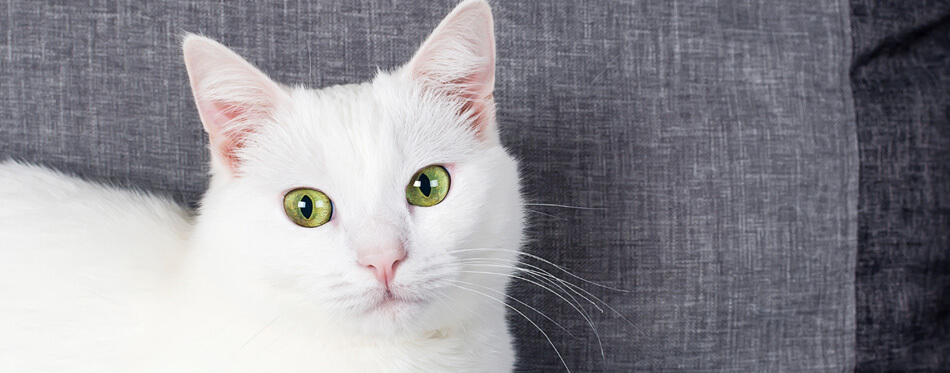
The Turkish Angora is the perfect example of a cat breed with a pure white coat with no exceptions. They ordinarily have yellow eyes, however, it is possible for them to be born with blue eyes. Their large ears give them a look of constant alertness, whilst their pointed face can make them appear quite stern.
Turkish Angoras originate from the mountainous regions of Turkey and are highly active cats as a result of that heritage. This white fluffy cat breed is highly intelligent and affectionate at the same time, making them fantastic family cats.
Persian
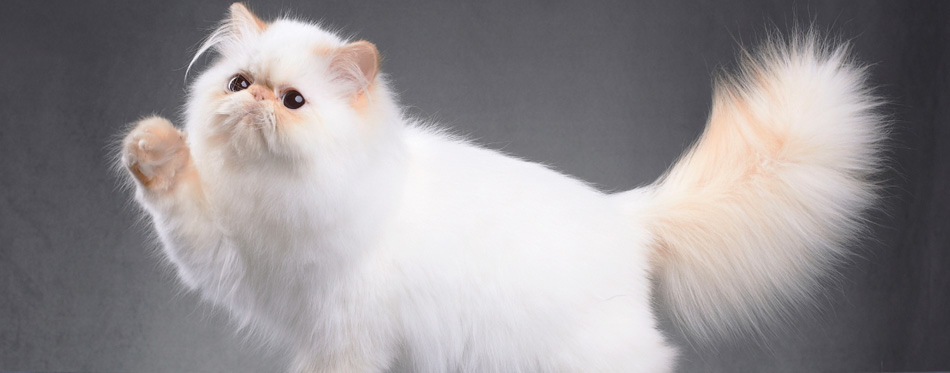
The most classic example of a white cat breed, the Persian cat. Persians are much-loved for their docile nature – making them great family cats. They’re also loved for their flat facial features as the result of many years of specific breeding, which gives them a somewhat grumpy look. This flat face can also cause breathing problems, which are very common in Persian cats.
These long-haired cats are known to be quite needy and require plenty of attention, so they must be kept in a home with a constant human presence. Additionally, their long coats need plenty of care, with daily brushing, if possible, to avoid matting.
Russian White
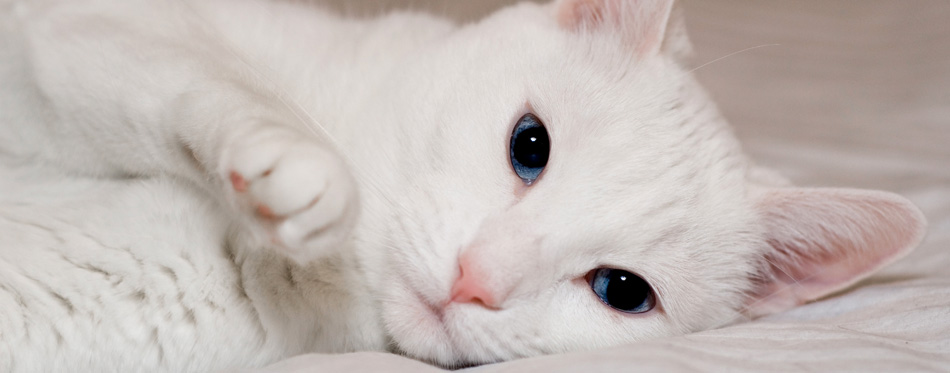
Also going by the name Archangel cats, Russian whites are a variation of the Russian Blue cat breed. Russian blues come in blue, white, and black. This breed is often used in advertising as it has many of the standard cat-like features. They’re playful and easy-going, which makes them particularly well-fitted to family environments.
Once with a family, Russian Whites do become very attached. However, they don’t generally take particularly well to strangers and tend to be aloof and cool towards a new face. They have short fur and streamlined bodies which are great for exploration, making them excellent outdoor cats. Furthermore, their fur doesn’t require a lot of maintenance, just give them a brush once a week or so.
Oriental Foreign White
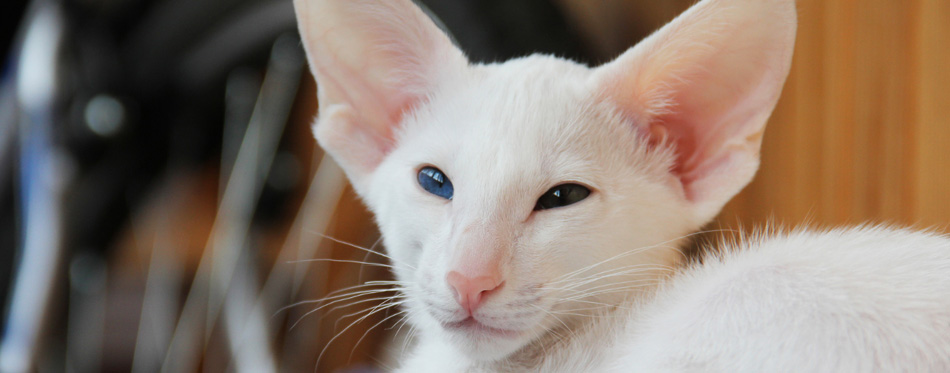
Also known as the Oriental Shorthair, Oriental Foreign Whites are highly unusual-looking cats, with exceptionally large ears that dwarf their small, pointed faces. Furthermore, their naturally narrowed eyes give them a look of constant distrust. However, they are in fact exceptionally affectionate cats that dote heavily on their families.
This medium-sized white cat breed has a 50/50 chance of being born with yellow or blue eyes and is born as the result of crossing Siamese cats with the British Shorthair. Evidently, the Siamese genes are dominant, giving them their distinct Siamese appearance with the soft, fluffy coat of a British Shorthair.
American Curl
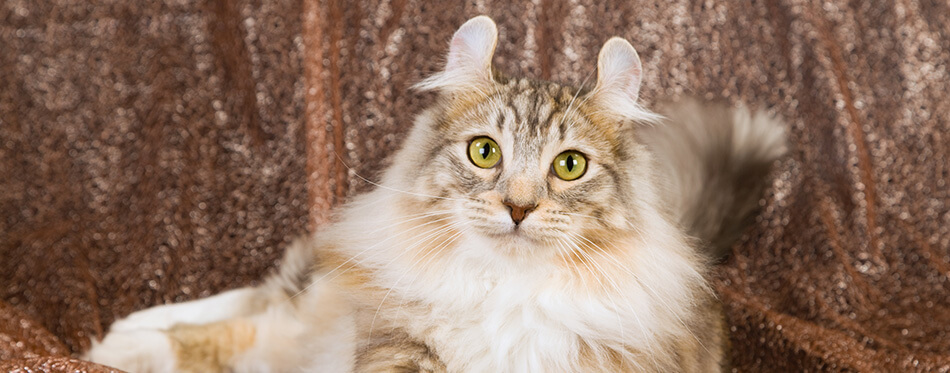
So named because of their uniquely curled ears whilst have a rounded appearance from the front. American Curls come in several colors, with the white cats having soft blonde/ginger stripes across their body and head. Their fur can vary from a short silky coat to long and fluffy, so make sure you research the best grooming methods depending on the coat length if you decide to get yourself an American Curl cat.
This is one of the more fun-loving white cat breeds, affectionately known as the “peter pan cat” because they can keep that youthful playful energy all the way up to adulthood – these cats love to play. This either makes them a great fit for houses with other pets or a bad fit if the other pets don’t enjoy being bothered.
Turkish Van
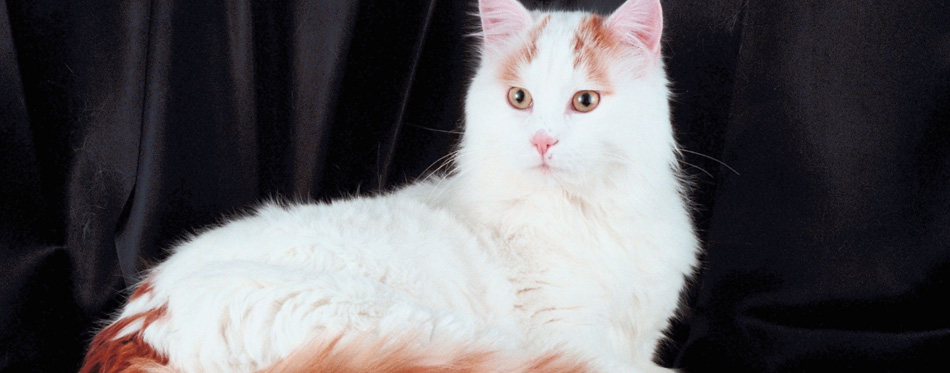
Best suited to an outdoor lifestyle, Turkish Vans are mostly white with distinctive colored patches across their heads and tails. They have thick coats as well as long hair. This dense coat means they can withstand harsher outdoor environments. This beautiful mostly-white cat breed loved to explore, meaning if you’re looking for a house cat, maybe look elsewhere – they don’t enjoy feeling trapped.
They are a medium-sized cat has a bit of a reputation of being destructive if they become bored, as they are highly intelligent. Furthermore, perhaps unexpectedly, Turkish Vans love water! You’ll often find this mischievous feline splashing at pools of water with its paws. They are generally gentle cats, just a bit on the cheeky side.
British Longhair
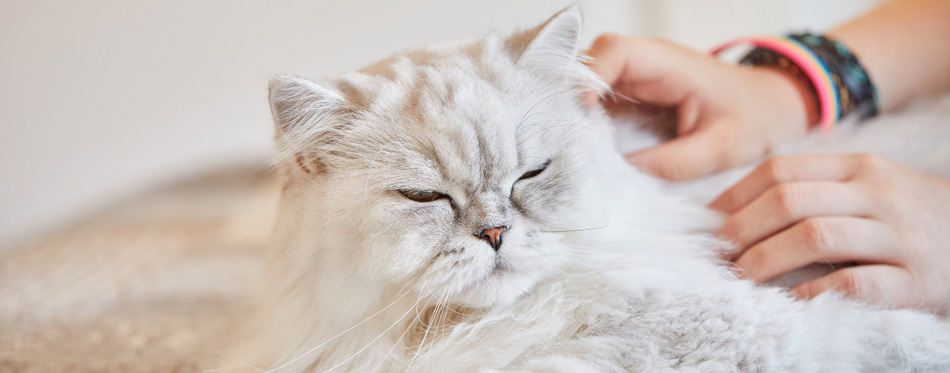
A cross between British Shorthairs and Persians, British Longhairs are the healthier equivalent of Persians owing to their British Shorthair genes giving them a longer snout. This does not prevent breathing problems, however, as their noses are still significantly flattened. Though the risks are greatly reduced.
They require constant grooming to keep their beautiful long white coats from tangling. Additionally, British Longhairs are a friendly breed, with an inherited docile nature from their Persian parentage. Though anyone looking to purchase a British Longhair should be aware that this stunning fluffy white cat breed is known to struggle with separation anxiety and benefits best from a full household.
Siberian Cat
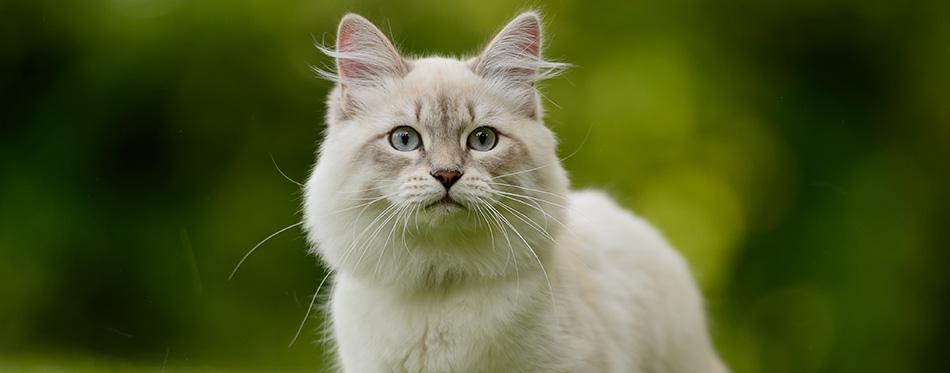
Muscular, with a triple-layered ultra-thick coat, Siberian cats are built to withstand the harshest weather conditions, meaning they make fantastic outdoor roamers, and don’t appreciate being locked indoors all day every day. They are naturally adventurous and playful, so make sure you spend lots of time bonding with your kitty whilst they’re young and use that fun-loving nature to your advantage.
They are a large long hair white cat breed in need of plenty of grooming to maintain that silky fur. You’ll notice, unlike other cat breeds, they have tufted fur around their paws as well as their ears – another sign that their Siberian roots have created a cat built for the elements. They are an active, intelligent breed that can even be taught a trick or two if you’re looking for ways to engage your fluffy feline friend.
Norwegian Forest Cat
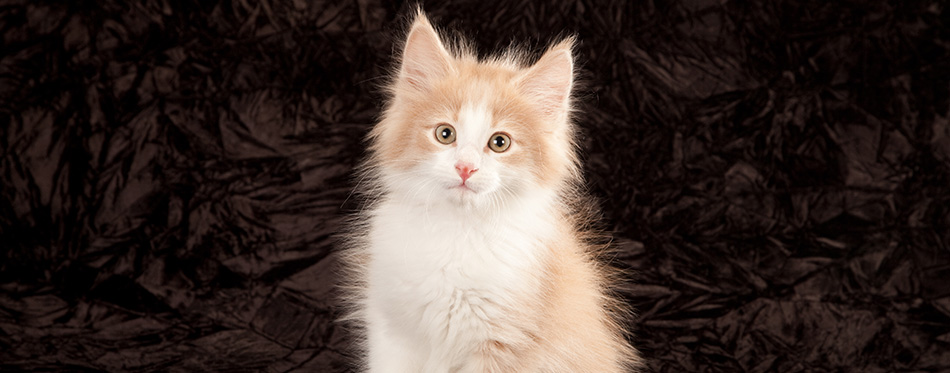
Norwegian Forest Cats were almost extinct during WWII, but were swiftly rescued as the result of breeding efforts in Norway following the war. This beautiful white breed is highly independent, with a tendency towards giving strangers the cold shoulder. However, given the chance to properly bond, a Norwegian Forest cat can be inseparable from its family.
The Norwegian Forest cat is also another example of a cat breed that enjoys playing around with water. Their coat is extremely thick due to their history as a northern-European breed, which means it will take a bit of maintenance to prevent matting. These are large cats with a taste for nature, so they should be allowed to explore their surroundings and enjoy nature.
British Shorthair
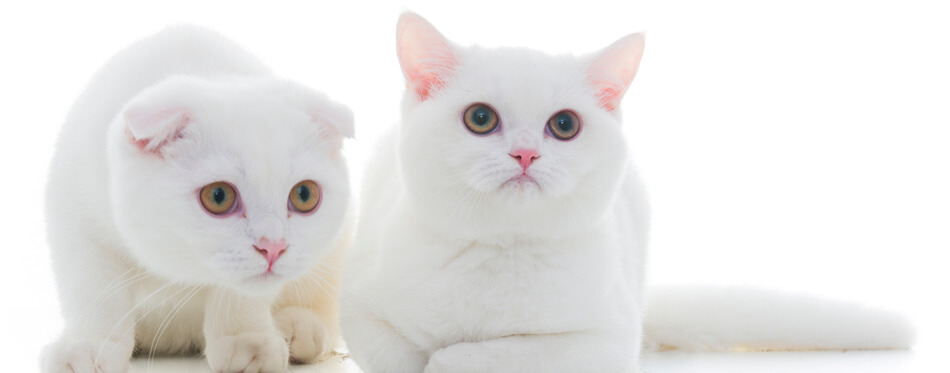
British Shorthair cats are one of the oldest breeds in Britain, originating in Ancient Rome and officially recognized by CFA in the 1980s. They have loveable round faces with wide round eyes to match. They are not always completely white kitties, however, most British shorthairs have dark patches of fur around the face and a dark tail to match.
They are an easygoing breed with a deep love for their human family. In fact, many British Shorthair owners recall how their little white kitty likes to follow them from room to room. Funnily enough, this affectionate personality trait does not necessarily mean they enjoy being manhandled, with many British Shorthairs preferring to stay with all four paws on the ground.
Siamese Cat
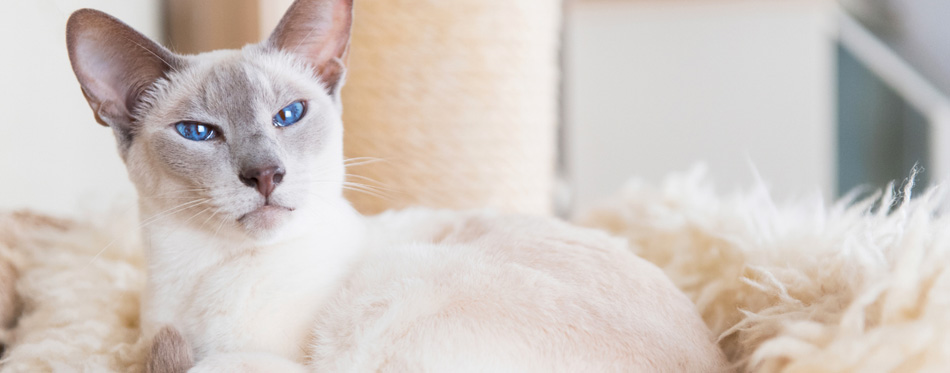
Siamese cats are easily one of the oldest cat breeds on our list. This ancient breed has been the key to the development of the Oriental Shorthair, with distinctive long ears and a narrow pointed snout unique to this breed alone. Most people picture a Siamese kitty with a dark face, dark paws, and a dark tail. You would be correct in assuming this, however, they don’t always develop this coloration.
A fun fact with Siamese cats is that they are all born completely white, so you have to wait a couple of weeks to see if they start developing any color – which will then mature to a deeper shade reaching their lifelong color by the time they are one year old. Siamese cats usually have striking blue eyes that practically glow with color, and are also predisposed to sight and hearing problems. Something worth noting.
Maine Coon
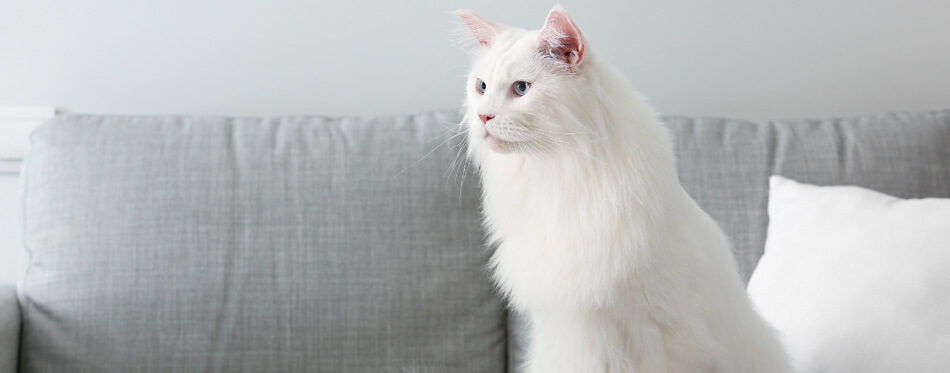
A famously large breed with a dense coat of shockingly white fur, Maine Coons are quite spectacular to behold. They have a natural air of confidence about them with a regality that comes from the sweeping, proud mass of fury surrounding their head and chest region. Though in juxtaposition to this, Maine Coons are playful, affectionate, and outgoing.
Maine Coons are also seen as the official cat of Maine, as suggested by their name. They are especially playful kittens that don’t lose that playful nature in maturity, they simply calm down slightly. Though a helpful note with this breed is that they don’t reach full maturity until they are around 4-5 years old. Maine Coons are also considered to possibly be descendent of cats brought to the region by Vikings.
Scottish Fold
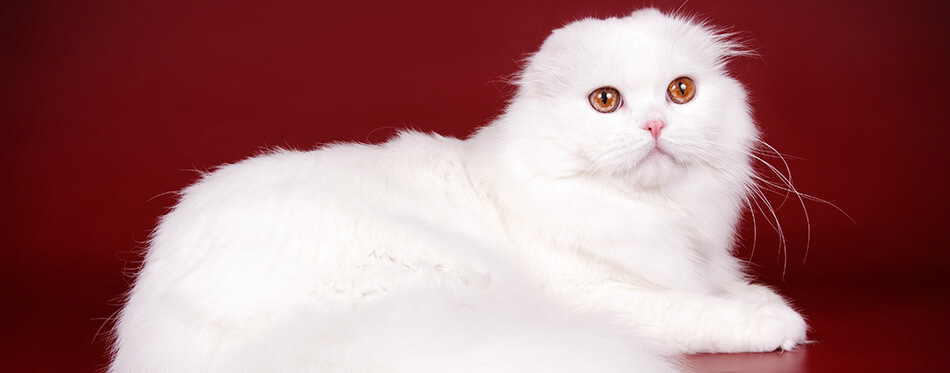
Getting their name from their uniquely shaped ears, Scottish folds a natural more grey than white, however, it is possible to get an all-white Scottish fold. The folded ears are the result of a genetic mutation that affects the development of cartilage, meaning they appear more flattened than their other feline counterparts.
Many people often make the mistake of assuming that the cat may be feeling aggressive or afraid, which is a natural assumption given that they appear to be flattening their ears by choice. However, it’s simply a matter of genetics. The Scottish Folds‘ coat is extremely dense and sheds often, so to reduce fur around the house and to keep the skin healthy it’s best to keep on top of a regular brushing routine.
Ragdoll
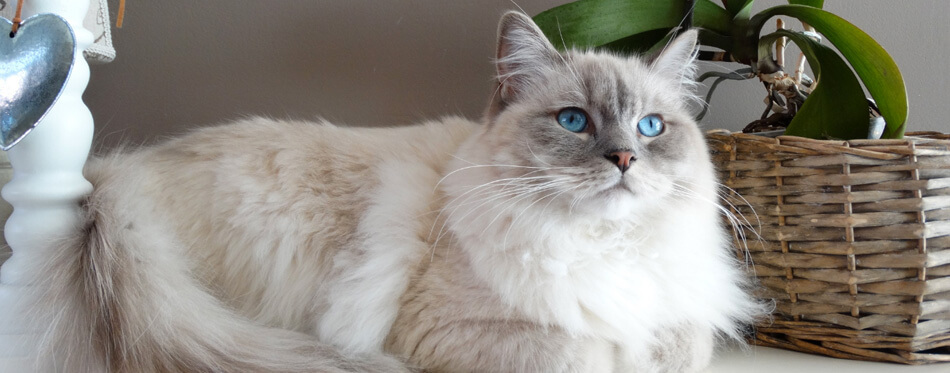
Ragdoll cats can have a white/grey coat or a white/blonde coat, depending on the feline. They are often confused for other cats such as the Himalayan cat, or the Balinese, however, the Ragdoll breed generally had a much paler coloration. They are a fluffy breed with especially long fur around the tail and chest areas. The Ragdoll coat is also especially thick, meaning there is plenty of shedding and a high risk of matting, so stay on top of their grooming.
Ragdolls get their adorable name from their tendency to become highly attached to their owners and comfortable with being held by them (meaning they will ragdoll with relaxation when being carried). This docile nature and affectionate behavior make them especially good family cats. They’re happy indoors and patient with children, though be sure to teach any children the appropriate way to handle a cat – their patience will only extend so far.
Himalayan Cat
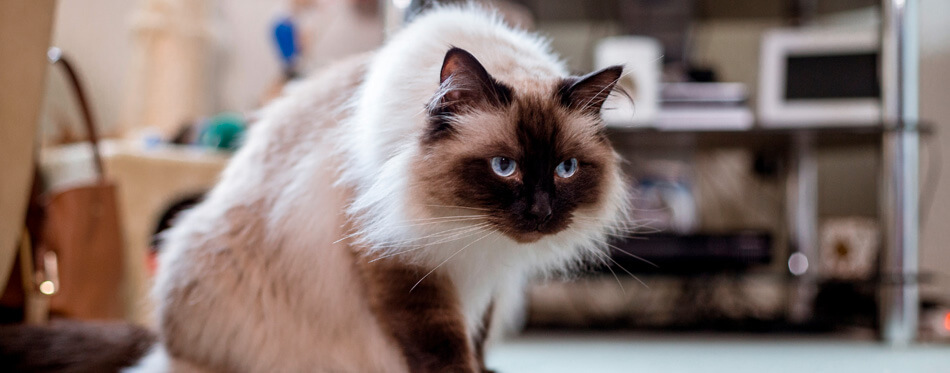
Himalayan cats share a similar coloration to Balinese cats, however, they have much thicker, longer fur. Their startlingly blue eyes make for a brilliant contrast against the dark fur around their face. Additionally, they often have flatter facial features akin to that of a British Longhair or Ragdoll. Depending on the severity of these features it may be worth watching out for potential breathing problems.
Himalayan cats have a characteristic point of fur at the tips of their ears which is another defining feature that can make it easier to separate this breed from other breeds with similar features. They are medium-sized cats with a playful nature and oodles of patience when it comes to their family. Just show them lots of love and attention and they will dote on you right back.
Japanese Bobtail
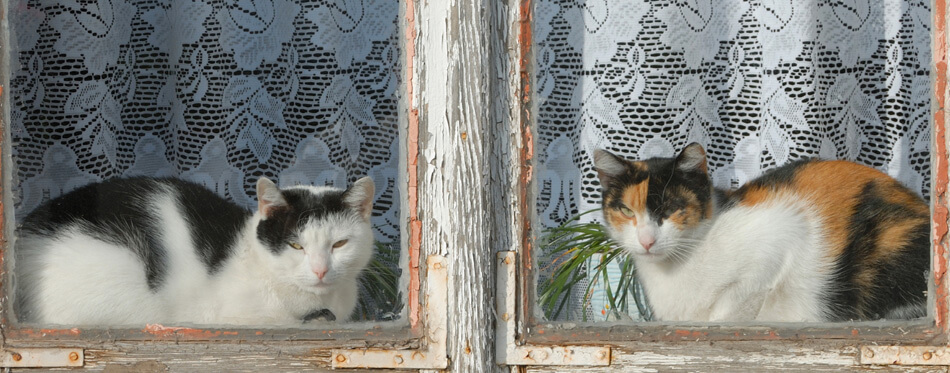
The Japanese Bobtail is certainly not an all-white breed, but we feel the percentage of white to colored fur has earned them a mention on our list. Japanese bobtails can be recognized by the large patches of color the can be found on their heads, backs, tails, and hind feet. This color can either be black, ginger, or a mixture of both. They have white, round eyes that give them a kind look, along with soft round faces to match.
As you would perhaps expect from the name, Japanese bobtails have what appears to be a docked tail. Fortunately, there’s no actual docking happening, and the shortened tail (which is usually just a couple of inches long) is the result of a genetic mutation that runs on the breed. They are an ancient Japanese breed believe to bring good luck. They are even featured as the “waving cat” figurine which is kept as a good luck charm.
Balinese
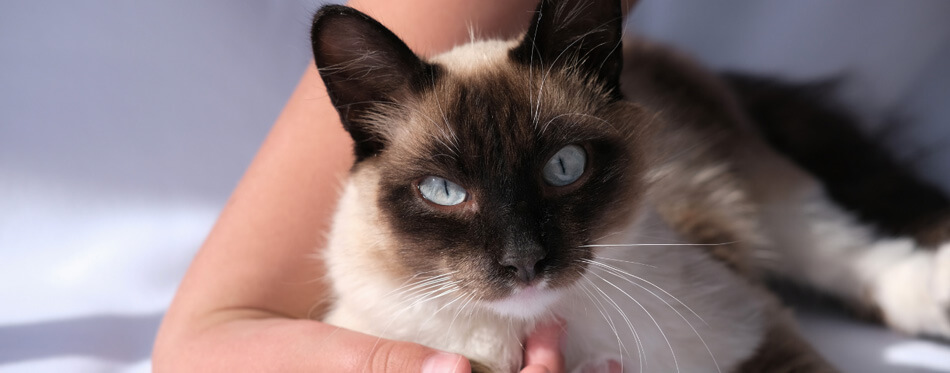
Also known as a Long-Haired Siamese cat. Ironically, they only have a semi-long coat and are not particularly fluffy when compared to long-haired white coat breeds. As discussed previously, Balinese cats bear a striking resemblance to Himalayan cats to the untrained eye. Though they are slightly smaller in stature, with larger ears relative to their heads and generally shorter fur.
Much like their Siamese cousins, Balinese cats are all born white or cream and will develop their color (if at all) within the first year of their life. It is entirely possible that they can remain pure white for their entire life. They are loyal, gentle, affectionate, friendly, and very vocal. If you own a Balinese you will likely get used to the sound of them meowing and yowling whenever the mood strikes them.
Snow Bengal
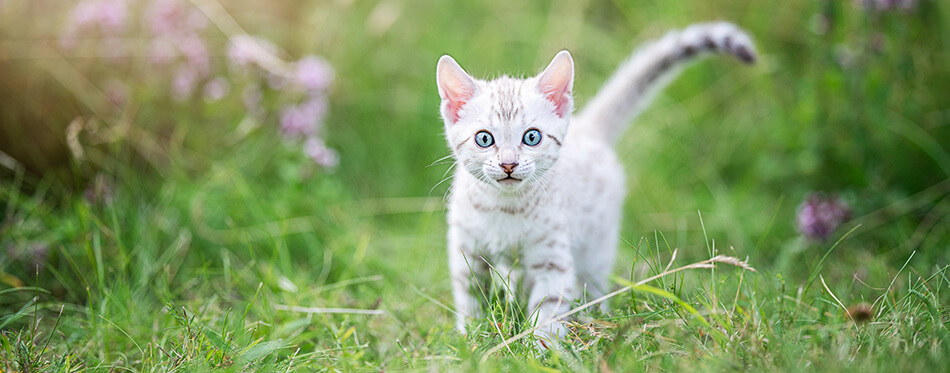
So named because of their fur pattern matching that of a Bengal tiger, Bengal cats also have a snowy cousin, otherwise known as the Snow Bengal. The major difference being the base color of their coat. Unlike other cat breeds on our list, with mostly white fur, Snow Bengals still retain the majority of their pattern, but the white or cream base color makes them stand out among other Bengal cats.
They are considered one of the larger cat breeds, as they can grow to be as heavy as 15 pounds in some cases. They generally have piercing green eyes and a thick coat to protect them against the elements whilst exploring. They can be quite demanding of attention and get themselves into trouble if they don’t feel like they’re getting enough, so keep that in mind!
Check out our guide on Bengal Cat Food for more info.
Devon Rex

Devon Rex cats are a small to medium cat breed. Their long, thin bodies are covered in dense wavy fur which gives them an endearingly disheveled quality that Devon Rex owners love. This is also something that is extremely rare in the feline world, making them quite special in their own right.
Devon Rexes actually bear quite a strong resemblance to sphynx cats in terms of their facial structure and exceeding large ears. However, Devon Rexes generally have wider heads than the Sphynx breed and much longer legs. Despite their naturally harsh expression, they are actually very gentle cats that seek the care and attention of their family. Additionally, a Devon Rex can make an excellent family cat owing to its gentle nature.
Sphynx Cat

So technically the Sphynx cat doesn’t fit in any category when it comes to hair color, seeing as it has none. However, interestingly there is still a way to tell what color the Sphynxs’ hair would have been, had they grown any. It is simply a matter of checking the color of their skin. Sphynx cats will develop patterning in their skin akin to that of a fur pattern, with patches of dark grey skin showing where the darker hair would have come through.
A Sphynx that is all pale pink is considered to be a white Sphynx. They are definitely a breed for people of specific taste, as the Sphynx breed isn’t everyone’s cup of tea. But for anyone willing to give them unusual and unique kitty a chance, Sphynxes are people-oriented, outgoing, playful, and mischievous. They’re also highly intelligent and talkative, so you can expect a good conversation with this one.
How Do Some Cat Breeds Become Pure White?
Pure white cat breeds are actually very rare in the feline world. There are only a limited number of solid white cats that carry the white gene, which controls the possibility of a cat developing patterned fur coats. If a breed is not known for being white, then pure white cats within that breed are usually affected by something known as feline albinism.
What is Feline Albinism?
Feline albinism is a natural genetic mutation characterized by a complete lack of pigment and makes for a very rare breed. This affects both the cat’s coat and eye color, with albino cats having pure white fur and pale blue eyes. This genetic mutation can also cause several health problems including deafness and blindness. This recessive gene is most commonly seen in Siamese cats and Burmese cats. Cats can be tested for the albino gene if an owner wants to check for it.
However, it is not simply recognized by white fur and blue eyes. If your feline friend is born with blue eyes, it could simply be a case of natural coloration. Seeing as albinism is such a rare genetic disorder, pet parents may wish to do a coat color panel before pursuing an albinism test.
Common Health Problems For White Cat Breeds
There are a couple of prominent health problems that have a higher chance of affecting white kittens. Knowing what they are and what to look out for can help you to adapt to suit their needs.
Blindness
White cats are not necessarily blind, or even short-sighted. Additionally, it’s important that to remember that every white kitten – or every kitten in general for that matter – is born with blue eyes. You need to give them time to change color (if they will) and mature before deciding whether to look out for short-sightedness or blindness. Though a key sign of potential blindness in a white cat with blue eyes. The symptoms of short-sightedness or blindness include:
- uneven or wide pupils
- lack of coordination and balance
- bumping into objects and furniture
- confusion
- walking slowly
- walking with wide and deliberate steps
- reluctance to jump
It is possible to have your cat’s eyes checked if you feel they may be struggling with their eyesight. Just book an assessment appointment with your veterinarian.
Deafness
Deaf cats are more common than you might think when it comes to white cat breeds. Especially if an all-white cat has the albino gene, which is a very common cause of deafness in white cat breeds. The only way to be able to tell if your cat might be hard-of-hearing is by watching their behavior and recognizing the symptoms:
- Lack of response when called
- Pawing at their ears
- Shaking their head
- Disorientation or dizziness
- No fear of loud noises (such as the vacuum)
- Easily startled by physical and visual interactions
Deafness can be permanent in white cat breeds depending on the severity of the condition. However, it’s also worth noting that deafness and hearing problems can be temporary – caused by a reversible condition that can be treated. Like with blindness, if you notice these symptoms on your cat, give your vet a call for a second opinion.

